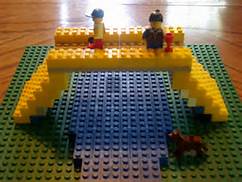….some years ago in a Scottish secondary school, I remember helping to co-ordinate a “team building” exercise with 14 year-old students. A large group of young people was divided into several teams of six. Each team was given a few flimsy sheets of A4 paper and a dozen paperclips. Using only those materials, their task was to construct a bridge between two chairs set several feet apart. The bridge had to be capable of taking the weight of a toy car and the task had to be completed within ten minutes.
Now there’s something for you to try with family and friends some autumn evening when the nights have drawn in and conversation is a bit sparse.
I was reminded of those happy days recently on reading a short newspaper article about a talk Matthew Barzun had given. Matthew, as you probably know, is the US ambassador to Britain and he was addressing members of the Scottish Confederation of British Industry (CBI). The main thrust of his talk was that people, especially people in politics, seem to find it easier to build walls than to build bridges. He may have been thinking of his fellow American, Donald Trump, or, since he was addressing a Scottish audience, he may have been thinking of a situation closer to home. Who knows?
Whatever was the case, he made the point that his son enjoyed playing with Lego and that most people, faced with a pile of Lego bricks, would choose to build walls rather than bridges because it is easier.
He went on: “What is easy is building walls. Anyone can build a wall; building bridges is harder. Building bridges requires you to understand the other, listen to the other and to explore the other’s shore.”
I think I would enjoy an evening in the company of Matthew Barzun.
This summer, there has been a long period of silence from this blog. That’s because here in Scotland the sun has been shining for weeks and it has been too hot to be sitting at a computer. I jest, of course. Meanwhile in the real world, across the UK and abroad, we have heard a lot of strident noise and seen a lot of angry division. We have seen walls – political, metaphorical and racial – constructed between all sorts of groups. So it is refreshing to hear at least one influential voice suggesting that “exploring the other’s shore” might be a more constructive use of our energy.
To return to the young students – I still remember one of them when confronted with his team’s pile of paper and paper clips, saying to me in the direct way that 14 year-olds have: “What’s the point of this?” Before I could utter the standard teacher’s response, he went on with a smile: “At least we can talk to each other.”
And that’s the point, really.

